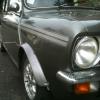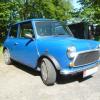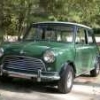
Temperature Gauge
#1

Posted 30 December 2011 - 10:50 PM
Info on electrical and capillary would be good, deciding which to buy.
#2

Posted 30 December 2011 - 10:50 PM
Standard 998
#3

Posted 30 December 2011 - 11:43 PM
Edited to say electrical will be half the price but won't have that 240° sweep.....
Edited by govig, 30 December 2011 - 11:51 PM.
#4

Posted 30 December 2011 - 11:55 PM
I like the capillary ones with the 240° (or is it 270°?) dials. All you need (assuming there's a threaded hole in the head under the stat) is a 5/8" UNF (18 tpi) double ended adaptor and the gauge itself. No electrical connection other than illumination and it reads when you switch off. If it's a later Mini without the threaded hole in the head, you might have a bit more thinking to do if you want a capillary. I believe you can buy a stat housing or a sandwich plate with a hole for an electrical sender which might be a bit easier.
Edited to say electrical will be half the price but won't have that 240° sweep.....
I've got a 1981 City, would this have the hole?
Also can you recommend any gauges?
#5

Posted 31 December 2011 - 01:51 AM

I would get a Smiths gauge. If you buy a secondhand gauge make sure you get the correct sender for it.
Edited by surfblue63, 31 December 2011 - 01:52 AM.
#6

Posted 31 December 2011 - 01:57 AM
I cannot comment on what would be on your engine. Open the bonnet and look at the engine. The most common gauge sending unit location is behind/above the alternator tapped into the cylinder head below the thermostat housing. Look for a green/blue wire on a brass fitting in that location.
For capillary gauges, you can spend a little or a lot. Performance wise I don't think you will find a lot of difference between cheap and expensive. I would start will a nice looking inexpensive capillary gauge and if you decide you like its performance, buy a more expensive gauge later if you find one you like the appearance of.
One caveat must be mentioned regarding the capillary gauges. The expansion bulbs that screw into the cylinder head can be "long". Sometimes they bottom out in the head casting before the tapered seat makes contact. When that happens you need an adapter fitting to move the expansion bulb out a bit. That fitting is available from Mini Spares.
#7

Posted 31 December 2011 - 11:34 AM
I agree that gauges with more needle sweep are easier to read and with more sweep offer more resolution. The electrical gauges are not hard to install and have a more "factory" look but typically have 90 degrees of needle sweep and therefore, less resolution.
I cannot comment on what would be on your engine. Open the bonnet and look at the engine. The most common gauge sending unit location is behind/above the alternator tapped into the cylinder head below the thermostat housing. Look for a green/blue wire on a brass fitting in that location.
For capillary gauges, you can spend a little or a lot. Performance wise I don't think you will find a lot of difference between cheap and expensive. I would start will a nice looking inexpensive capillary gauge and if you decide you like its performance, buy a more expensive gauge later if you find one you like the appearance of.
One caveat must be mentioned regarding the capillary gauges. The expansion bulbs that screw into the cylinder head can be "long". Sometimes they bottom out in the head casting before the tapered seat makes contact. When that happens you need an adapter fitting to move the expansion bulb out a bit. That fitting is available from Mini Spares.
Thanks.
1 user(s) are reading this topic
0 members, 1 guests, 0 anonymous users
















